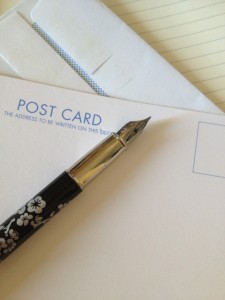In a conversation about marketing with my colleague Rich ‘An American Editor’ Adin,
I was reminded of how ‘sometimes the old ways are the better ways’ (Adin, personal correspondence).
Take old-fashioned snail-mail marketing. Sending letters is still as powerful a marketing tool today as it was 50 years ago. So why is this still a strong proposition? Might it even be a stronger proposition than email marketing?
10 reasons to write a letter
1. Better response rates:
Crawford Hollingworth, in ‘Slow snail mail – why the tortoise is still beating the hare’, notes that ‘[r]esponse rates to letters are typically 30 times better then email – around 3.4% for direct mail, compared to 0.12% for email in 2012’. Letters take more time and effort, but those numbers alone provide a persuasive argument for using your postie! I’d recommend reading Hollingworth’s article in full. The author uses the lenses of psychology and behavioural science to consider why the letter is still a great proposition when it comes to getting someone’s attention.
2. Permanence:
A letter is a physical thing – a piece of paper – and that means it can be physically moved around and read in multiple places. It can also be filed in a manner that isn’t deletable with one finger. This gives it permanence. You may not get positive results to your letter-writing campaign straight away, but having your information filed in the traditional way means it’s likely to survive longer in a drawer than it will in a digital inbox.
3. Psychology of perceived effort:
There’s something about a letter that tells your customer you’ve made an effort. In reality, if you’re crafting an email designed to solicit work, you’ll take just as much care over the content. But it’s the perception that counts here. Sending a letter tells the customer that you’ve done more than craft the content – ‘letters can evoke a greater feeling of commitment in us. We acknowledge the time and effort someone has put into writing to us, to stamping and posting the letter and this can make us feel more committed to responding’ (Hollingworth, n.d.). A letter offers the customer the personal touch – ‘[r]eceiving a tangible, physical item such as a letter is usually experienced as a more personalized and involved form of outreach than receiving an email or SMS’ (SpirE-Journal, 2010).
4. Differentiation:
When you send a letter you make yourself stand out precisely because you, well, send a letter. ‘These days 99% of correspondence is through email. So, a typed and mailed note with an attached résumé may just end up in the right hands,’ says Paul Gumbinner (2013). I’d add a caveat to this: I wouldn’t take the chance of a letter just ‘end[ing] up’ anywhere – it needs to be addressed to a named person for maximum impact. Nevertheless, Gumbinner’s point is that letters aren’t the norm so, when you use one to put yourself in front of a potential client, you differentiate yourself.
5. Damage limitation:
A letter can be handed from one colleague to another, or moved from one desk to another, without damaging the readability of the content. Most of us will have been on the receiving end of the passed-around email that’s become something other than what it started out as. Yes, I’m talking about chevrons. When you send an email there’s a risk that your beautifully crafted message will become corrupted by a plethora of ugly characters, all of which distract the reader’s eye from the reasons why they should hire you as their editor or proofreader. I’d repeat the caveat above – the letter does need to be correctly addressed. Too many pairs of hands forwarding it to your key contact could mean it ends up looking tatty, so do the research beforehand to ensure you have the right name on the envelope.
6. Marketing eye candy:
There’s no point in pretending that looks don’t count. They do. And emails are boring. The only way to make them attractive is to attach something, and that requires the receiver to hit yet another button. To do that you need to have already piqued their curiosity. With snail mail, the envelope itself piques their curiosity because it’s not the usual method of communication these days. Furthermore, not only can you design a letter so that it’s attractive, but you can also include additional items, e.g. a seasonally designed, branded postcard, a brochure or a business card, thereby making the whole package more interesting – what Hollingworth (n.d) calls ‘behavioural nudges’. Sending letters may be old-fashioned but it has the potential for creativity and inventiveness that’s very much in the ‘now’.
7. Absorption:
Yes, email is hugely convenient – I cannot conceive of being without it – but letters are harder to ignore. Compare the clutter of the email inbox to something physical on the desk. Most busy business professionals’ inboxes are jammed with emails from all and sundry. That, says Gumbinner, makes email ‘totally uninvolving. Some executives literally receive hundreds a day. They skip from one to another. Some are barely read, if at all. Few are absorbed.’ Standing out to your customer is about grabbing their attention and drawing them in. If they’re not absorbed in the message you’re trying to communicate, you’re less likely to secure editorial work from them.
8. Destruction factor:
It takes more effort for your customer to crumple and toss an appealingly designed letter and CV/brochure than it does to hit a ‘delete’ button on a keyboard – not much more, but just enough to give you an edge, especially when combined with the absorption and eye-candy elements mentioned above.
9. Sensory impact:
Your customer spends a lot of time at their desk and a lot of time looking at their screen. Thinking about differentiation once again, consider how you might be offering your potential client a little added value by writing to them. ‘A physical letter allows at least one extra sensory experience, namely the touch and feel of the paper,’ notes SpirE-Journal (2010).
10. Taking advantage of down time:
Snail mail allows your customer to kick back and relax away from the screen for a few minutes. They have to pick up the envelope, open it and then look at the content. That means they are focused on what’s in their hands as well as what’s hitting the back of their retinas. According to SpirE-Journal (2010), ‘Snail mail, unlike eDM [electronic direct mail], has a higher chance of getting read when the recipient is more relaxed.’ That’s good for you, because the customer is more likely to absorb themselves in the detail of the fabulous editorial services you’re offering!
5 things to do
1. Target a named person:
Remember to do the research beforehand (by email or phone) to ensure you can put the right name on your envelope. ‘If you want to make a good impression on the person in charge of hiring, you don’t want your letter and CV to look like it was used to wrap someone’s lunch by the time it ends up on their desk’ (Harnby, 2014). Precise, targeted addressing takes extra work but will yield dividends in terms of response.
2. Think about the content:
It’s not just about making sure the letter gets to the right person; it’s about holding that person’s attention once they’re reading it. When thinking about what to include in your letter and how to structure the content, you may like to consider my adaptation of Kevin Daum’s differentiation–solution–empathy framework for letter writing (Harnby, 2014: Chapter 20, ‘Going direct’).
3. Build a mailing list:
As you acquire the targeted names and addresses of your potential client list, record the information so that you build a mailing list. Having a mailing list is important because it enables you to market repeatedly to the same customers (Adin, personal correspondence). Why? Because clients don’t always respond the first, second or even third time round. That doesn’t mean you’re not a good fit for them. If your skills match theirs, they may just have forgotten you or been too busy with other things. Furthermore, those clients who do respond but who say their editorial freelancer lists are currently full will need a further nudge several months down the line. Having a mailing list takes the pain out of the re-mailing process because you’ve already done all the research.
4. Test:
Carry out trials to explore the impact of posting your letters at different times of year, with different enclosures, tweaked unique selling points or alternative postscripts. Different approaches may yield different responses and help you to hone your letter-writing craft and improve your positive response rate.
5. Track:
You won’t know how effective your letters are if you don’t keep track of when you sent them, to whom you sent them, what you tested and what the results were. It’s not just about tracking positive responses; it’s also important to keep a record of other future potentially positive outcomes, e.g. ‘we’re keeping your details on file’ or ‘our bank of freelancers is full at the moment, but thanks for getting in touch’. Those are very different responses to ‘thanks but no – we don’t use external proofreaders’, even though the immediate outcome in terms of work is negative. And all of those responses mean something different to the non-responder, who may simply have not got round to contacting you. Re-mailing non-responders and ‘on file or full up’ responders is a worthwhile exercise, whereas contacting the non-user is a waste of a stamp and a waste of your time.
Multiple tools, multiple channels …
None of this is to say that you should not exploit opportunities to put yourself in front of potential clients using digital tools. I think you should use these methods of making yourself discoverable. However, don’t assume that there is only one way to make first contact with a publisher, a business or an agency. Smart marketing involves exploiting multiple channels, some of which are bang up to the minute, and some of which have been powerful and effective tools of communication for generations.
Create a website, send emails, explore Google Authorship, build social media networks, make telephone calls, consider video testimonials, advertise in online directories, create business cards, blog … do all these things and more if you feel they’ll put you in front of your customer. But don’t forget the humble letter. You might be surprised at just how much business it can generate for you!
References
Gumbinner, Paul (2013). Making snail mail work for you [online], 2 April 2013. Available from View from Madison Avenue: http://viewfrommadisonave.blogspot.co.uk/2013/04/making-snail-mail-work-for-you.html.
Harnby, Louise (2014). Marketing Your Editing & Proofreading Business (in association with the Publishing Training Centre).
Hollingworth, Crawford (2013). ‘Slow snail mail – why the tortoise is still beating the hare’ [online], 15 July 2013. Available from the Marketing Society: https://www.marketingsociety.com/the-library/slow-snail-mail-–-why-tortoise-still-beating-hare.
SpirE-Journal (2010). ‘The Re-emergence of Snail Mail’ [online]. Available from Spire Research & Consulting: http://www.spireresearch.com/wp-content/uploads/2012/02/the-re-emergence-of-snail-mail2.pdf.
Based in the heart of the Norfolk Broads, Louise Harnby is a professional proofreader with 23 years’ publishing experience. An Advanced Professional Member of the CIEP, she specialises in providing proofreading solutions for clients working in the social sciences, humanities, fiction and commercial non-fiction. Her customers include publishers, project management agencies, professional institutions and independent writers. Louise is the curator of The Proofreader’s Parlour and the author of Business Planning for Editorial Freelancers and Marketing Your Editing & Proofreading Business. Visit her business website at Louise Harnby | Proofreader, follow her on Twitter at @LouiseHarnby or find her on LinkedIn.
Proofread by Jane Hammett.
The views expressed here do not necessarily reflect those of the CIEP.




